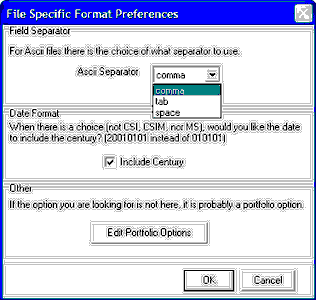The File Export Preferences offer several choices of formats, including ASCII. These text files present data in alphanumeric characters that can be read by people and computers.
If you plan to process UA data in ASCII files with third-party analysis or spread sheet programs, click the ASCII radio button under File Export Preferences.
ASCII Preferences
When ASCII is selected, the [Preferences] button becomes accessible. Click it to reveal the following ASCII choices:

Field Separator: The Separator is used exclusively in writing ASCII format data files, where it determines what will be used to separate the fields (open, high, low, etc.).
Click the symbol to the right of the text box to reveal your choices, as shown above.
Make your choice according to your preference or the requirements of your analytical, spread sheet or publishing software.
Date Format: When adding a portfolio item to UA, the File Export Preferences portion of the screen includes an "Include Century" prompt. This choice is used exclusively in writing ASCII format data files. It determines whether the year will be represented in two digits (without century) or four digits (with century). We recommend the century be included to preserve data integrity in cross-century analysis.
Example of date without century 041201 (December 1, 2004)
Example of date with century: 20041201 (December 1, 2004)
Of course, this is a Y2K issue. Some software written in the 20th century is unable to handle a four-digit year presentation.
Other
Several additional ASCII file preferences were selected during portfolio creation and correspond to the selected portfolio. Click the [Edit Portfolio Options] button to review and/or edit these options. They are explained in the Edit Portfolio Setting chapter under "Settings Affecting ASCII Files." Please check there for details on:
Note: The CSI (QuickTrieve), MS and CSIM formats are binary formats, NOT ASCII formats.
The makers of some UA-compatible programs have supplied CSI with the necessary information to pre-establish compatibility. Ask your system developer for details.
